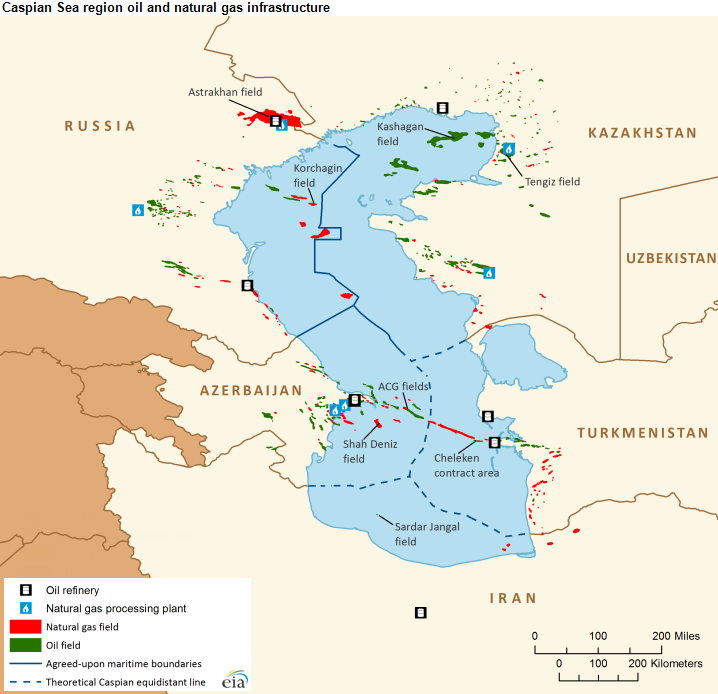Even as Russia discusses a production freeze with Saudi Arabia, Caspian Sea projects could add to the glut
Oil prices have improved this week in part thanks to renewed talks amongst Saudi Arabia and Russia to stabilize global oil prices. In a joint statement Monday, the energy ministries of both countries agreed to work together to “mitigate excessive volatility” in oil prices.
Given the glut that has persisted since late 2014, many thought this could indicate another attempt at a production freeze, but even as talks of stabilizing price take place, two new Caspian Sea projects could add 200 MBOPD to an already oversupplied market by the end of the year, reports Reuters.
The Caspian Sea region, which includes Russia, Azerbaijan, Kazakhstan, Turkmenistan, Uzbekistan, and Iran, is one of the oldest oil-producing areas in the world. The EIA estimated there were 48 billion barrels of oil and 292 Tcf of natural gas in 2P reserves in 2012, the most recent estimate from the agency, primarily in the northern part of the sea. The USGS estimates another 20 billion barrels of oil and 243 Tcf of gas is yet undiscovered, much of it in the South Caspian Basin, where territorial disputes have hindered exploration.
The two projects, the Kashagan field in Kazakhstan’s sector and Lukoil’s (ticker: LKOH) Filanovsky field in the Russian sector are both expected to come online in October, according to documents obtained by Reuters.
Output for Kashagan will initially be 75 MBOPD before rising to between 150 MBOPD and 180 MBOPD by the end of the year.
The companies involved in the project include:
- China National Petroleum Corp,
- ExxonMobil (ticker: XOM),
- Eni (ticker: E),
- Royal Dutch Shell (ticker: RDSA),
- Total (ticker: TOT),
- Inpex, and
- Kazakhstan’s KazMunaiGas.
The project began producing oil in September 2013, but stopped shortly thereafter due to a gas leak in its pipelines. The project is five years behind schedule, and costs for the first phase reached $55 billion, according to the project operator, North Caspian Operating Company.
The Filanovsky project will begin exporting around 50 MBOPD of light crude by the end of the year. Representatives of Lukoil confirmed the project will come online in 2016, but declined to comment on production figures.
“While Russia is lulling the world with stories about a freeze in production in order to stabilize prices, on its territory and in the countries of the [former Soviet Union] new fields are continuing to come on stream and it doesn’t look like anyone can do anything to stop it,” said an industry source who spoke on condition of anonymity.
Russia continues to develop onshore unconventionals as well
While Russia’s publicly-owned Lukoil looks to start new production offshore, state-owned giant Gazprom is developing its unconventional business onshore. The Gazprom’s oil division became the first Russian company to hydraulically fracture a well start to finish without the assistance of a Western company earlier this month.
While the 3,280 foot horizontal, nine-stage well was small in comparison to wells drilled in the U.S., it does prove the technical viability of unconventionals in Russia. Gazprom reported a flow rate of 330 BOPD with zero water cut from the well.
The economic viability is another story though. The oil in place is immature and slow to move, making it difficult to produce. The best spots to drill would likely be deep in the play, but the further down Gazprom drills, the less economic the wells will become.
Caspian Sea: actually the world’s biggest lake
According to numerous sources, the Caspian Sea is actually a lake, the largest lake on the planet—about the size of California. It is a salt water body, albeit its salinity is about one third that of seawater. The Caspian is a popular source of Russian caviar. The water depth is about 3,000 feet at the deepest zone and it contains almost half of the Earth’s total lake water volume—3.5 times the water volume held by the Great Lakes combined. The Caspian’s elevation is 92 feet below sea level.
According to some historians, the Caspian Sea is “the site of the world’s first offshore wells, which were built in the Bibi-Heybat Bay, near Azerbaijan’s current capital, Baku. Some of the largest oil fields known to exist at that time started being exploited in 1873, on the Absheron peninsula. By 1900, Baku was known as the “black gold capital”, with more than 3,000 wells.”
Many other petro-historians place the first offshore drilling in California, however.


